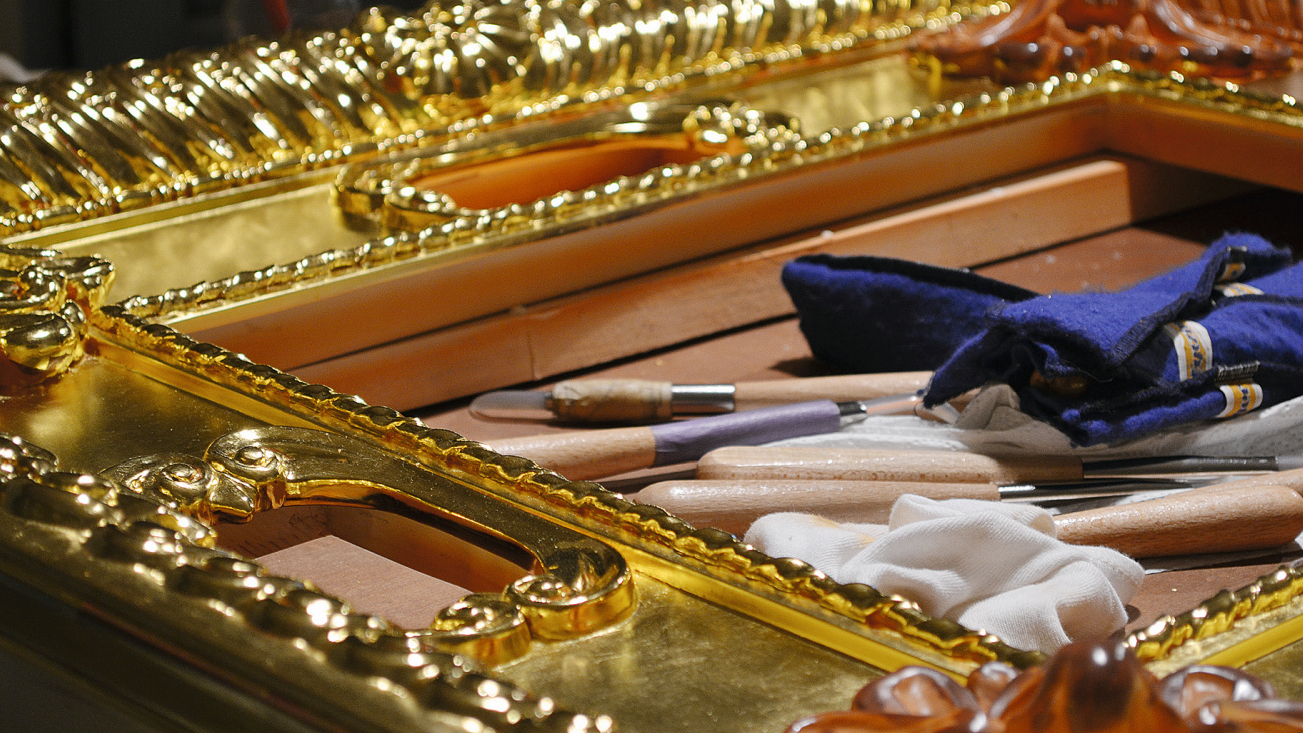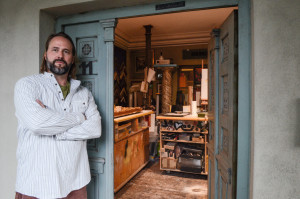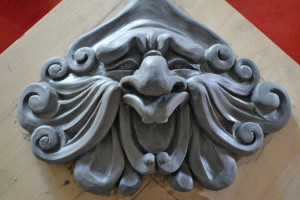With a network of 13 employees, a master gilder from the Palatinate is pushing the boundaries of his field: Benjamin Franck (45) and his company offer services that are not necessarily typical of this craft. However, he offers a wide range of surface designs on many different materials.
Craftsmanship, as the saying goes, has golden soil. And if this saying applies to carpenters and glaziers, it should apply even more to those craftsmen who come into direct contact with the coveted precious metal - such as gilders. "Unfortunately, that's not necessarily the case today," corrects Benjamin Franck. "Today, you have to come up with more ideas." The competitive situation is developing quite comfortably. Because fewer and fewer young people have the job description of a gilder on their radar - sorry the display. Franck: "When I did my apprenticeship in the 1990s, there were still 20 students in my vocational school class. Today, there are just six students in the class of my three apprentices." Incidentally, this leads to classes being brought up to normal strength through joint lessons with wax pullers and church painters.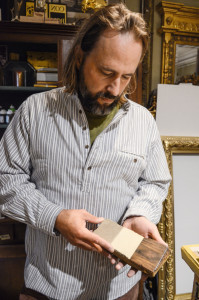 Designing stone: On the left of the sample is the grey, untreated stone. The intermediate layer of glue and chalk is visible in the middle, onto which a wooden pattern is finally painted
Designing stone: On the left of the sample is the grey, untreated stone. The intermediate layer of glue and chalk is visible in the middle, onto which a wooden pattern is finally painted
A Renaissance frame as a masterpiece
So it is more the market that is changing. Whether it's the public sector, churches or private individuals, people today are forced to look at the money. The fact that Franck's business is still successful is mainly down to two things: He is good and he is creative. This innate creativity has led him, as he puts it, to leave "the four corners of a gilded picture frame" (original quote) and turn his attention to other possibilities.
Franck completed his three-year apprenticeship at the Lauth gilding workshop in Ludwigshafen. However, his achievements brought him to the attention of two people from completely different fields: Helmut Hirmer, a calligrapher from his home town, and Marcel Chaudot, a French (but Speyer-based) stucco artist. Hirmer opened up the world of books and writing to Franck, Chaudot the world of plaster and stone. Both experts together, however, made Franck realize: "Beyond the possibilities of gilding, a much larger and more exciting field of activity awaited me. Namely the preservation of monuments."
However, this had to wait until after his apprenticeship. Franck traveled the world, visiting Spain, Iceland and Denmark, and only found his way back to his craft after working in a gallery in Copenhagen. In 2005, he set up his own business in Neuhofen (Palatinate). This was made possible for the journeyman by the then new legal provision that since 2004 a master craftsman's certificate is no longer required for professions similar to crafts. However, he obtained one anyway. In 2013, he passed the master craftsman's examination at the Hamburg guild.
Franck also solves tasks beyond gilding
As a masterpiece, Franck presented the examination board with a perfect copy of a Renaissance picture frame. The original includes the portrait of a Medici scion and hangs in the Ashmolean Museum in Oxford. The museum unbureaucratically took the picture out of the exhibition for two days so that the budding master could measure the frame at his leisure and record and document all its facets.
In this context, Franck explains that there are two methods of restoring a wooden picture frame - an expensive one and a cheaper one. The expensive method replaces the damaged parts with wooden parts carved with micromillimeter precision, while the cheaper method replicates the damage with what is known as spinning compound. This is a paste-like substance made from animal glue, cellulose and chalk. Whether wood or spinning compound: the replaced parts are then covered with gold leaf and smoothed with an agate stylus.
However, an intermediate layer is applied between the carrier material and the gold leaf and the material of this intermediate layer determines the respective method: in the case of poliment gilding, the layer consists of clay and hide glue. Oil gilding requires an intermediate layer of boiled linseed oil. And mordent gilding is applied to a wax-based layer. This last type of gilding is no longer very important in everyday business; today it is only used in churches. And all three intermediate layers are basically adhesives that ultimately fix the gold leaf to the substrate. Whichever of these methods is used, it is important to get the timing of the gold leaf application right. Franck: "The adhesive layer must neither be too soft nor too hard. Both conditions lead to unsatisfactory results."
Other materials that Franck faces, particularly in the field of monument preservation, are plaster and stone. Many a head of state from the time when Germany was still a patchwork of independent principalities, margravates, mini-kingdoms and duchies could not afford real marble. The solution was plaster! So walls and columns were built out of stone and covered with a layer of plaster, onto which a talented painter could then apply the noble-looking "marble look" with paint and a brush.
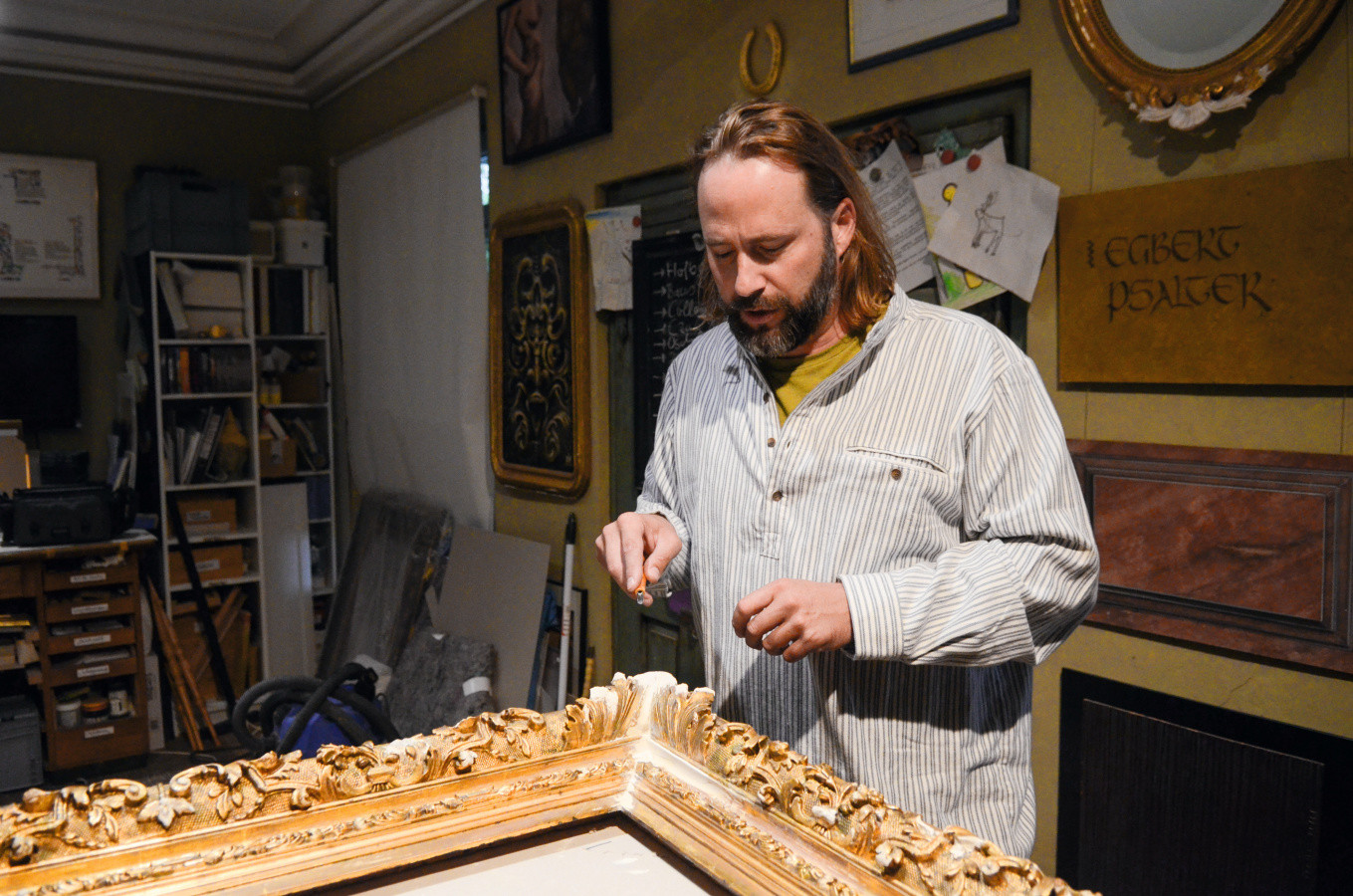 Restoration work on a baroque frame
Restoration work on a baroque frame
The gilder combines the academic with the artisanal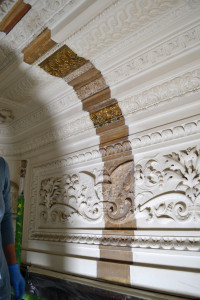 Exposure of stucco surfaces. After removing the lime paint, the original design is revealed
Exposure of stucco surfaces. After removing the lime paint, the original design is revealed
Restoring these elements today is just as much a part of Benjamin Franck's range of tasks as polishing up faded lettering in public buildings or churches. Here Franck works in the field of calligraphy. As it has become rather out of fashion to maltreat mankind with sayings, promises or even threats, there is hardly any demand for new versions. Franck estimates that 75% of his work involves restoring existing lettering and only 25% is new.
Whenever something is restored today, whether it is made of wood, stone or metal, two, let's call them, worlds come into play: the academic world and the world of craftsmanship. The academic side is concerned, among other things, with the interpretation of objects, their historical context and their classification. In addition, laboratory investigations, elaborate mapping and documentation are part of the academic field of activity. The craft aspects deal with the direct implementation: material, coloring, production technique. Today, one would perhaps say that the academic aspect corresponds to the software and the craft aspect to the hardware of an (art) object. It is very important to Benjamin Franck that both aspects are taken into account in all his work. His closest professional network therefore includes experts from both worlds, with Franck's staff taking on much of this work for the academic branch. In this way, both worlds benefit from each other.
Franck copied the step into modernism from the aforementioned stucco artist Marcel Chaudot. In his early years, Chaudot designed the winter garden of the cruise ship "MS Deutschland" together with Franck - old craftsmanship such as stuccoing or gilding is still used in this modern field today.
Touchup: a step into the modern age
Franck calls this area of activity Touchup: the refurbishment of modern surfaces in the VIP area. Among other things, Franck works on yachts, in airplanes or in lounges where the super-rich meet. But he doesn't reveal any more. In addition to craftsmanship, the focus here is on one thing above all: discretion.
When asked about the future prospects for his line of work, Franck doesn't think twice. In view of the uncertainty in many sectors of the economy, large restoration jobs are likely to become rarer. Even the two churches, which are not exactly suffering, are cutting corners. "Young colleagues who want to set up their own business in a few years will probably have to concentrate more on the four golden corners of a picture frame again."

